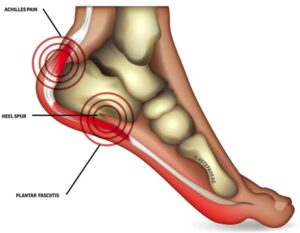There are many causes for heel pain. They range from simple mechanical issues to complex metabolic diseases. One of the most common reasons for heel pain is faulty foot structure. For example, flat feet or high-arched feet, wearing non-supportive footwear on hard, flat surfaces, or even obesity can cause heel pain. Plantar fasciitis, Achilles tendonitis, arthritis, or a stress fracture can all be contributing factors for heel pain. Because there are many different causes, it is recommended that you see a specialist so that you can be properly evaluated diagnosed, treated.
The most common complaint for heel pain is plantar fasciitis, a condition that affects the bottom of the foot. Plantar fasciitis is an inflammation of the band of tissue (the plantar fascia) that extends from the heel to the toes. In this condition, the fascia first becomes irritated and then inflamed, resulting in heel pain. Morning pain and pain after periods of rest is characteristic and can progress to pain all the time. As the pain worsens, the heel can hurt even while not weight-bearing.
 What is the treatment for heel pain?
What is the treatment for heel pain?
Most people suffering from heel pain recover with conservative non-surgical treatments.
Plantar Fascia-Specific Stretching Techniques.
- Anti-Inflammatory Medication.
- Physical therapy to calm the inflammatory process.
- Recommended shoe gear (both dress and athletic) that we individually match to each patient’s foot type, body type, and activities.
- Custom orthotic devices are made using a state-of-the-art laser scanner. These devices are made to fit either your dress or athletic shoes to help distribute pressure across your feet more evenly and correct the underlying structural abnormalities.
In some cases, injection therapy is used to help reduce the inflammation and relieve pain. If conservative treatment fails there are minimally invasive as well as surgical options.



